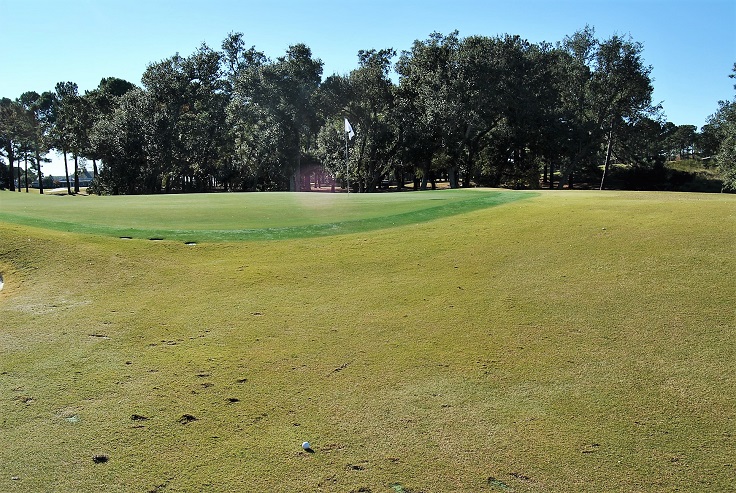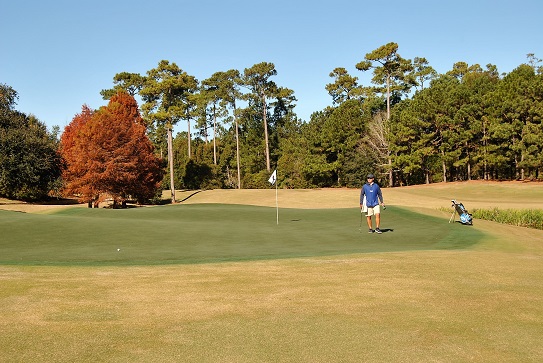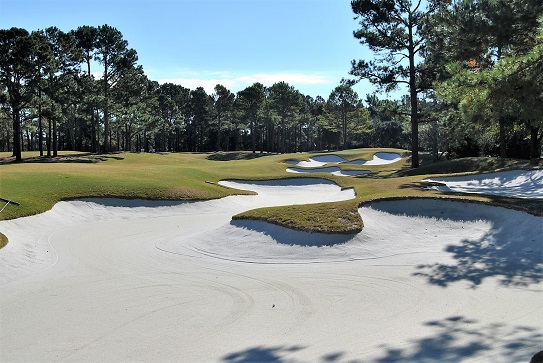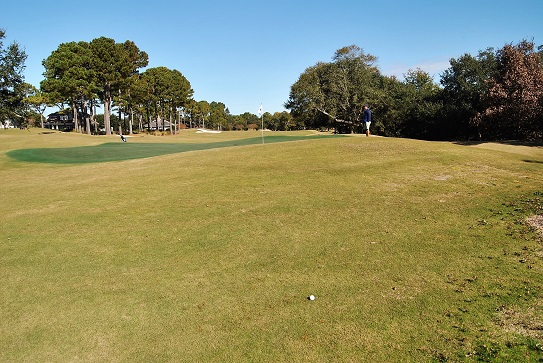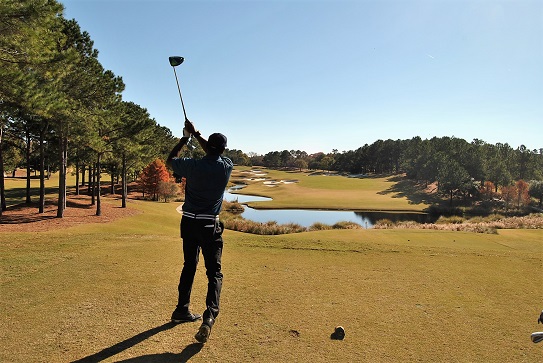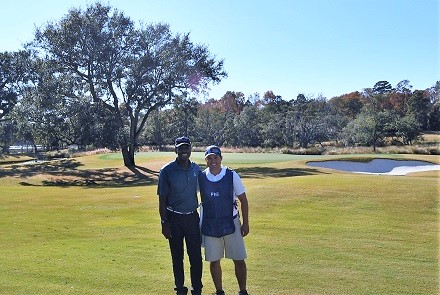On a day as beautiful as the day before when I played Pinehurst No. 2, I awoke without any of the ailments of the previous day. Today’s round was scheduled for Eagle Point Golf Club. A golf course that I’d never heard of prior to beginning my quest to play the top 100 courses in the US as ranked by Golf Digest for 2017-18. As I made the turn into the facility I was impressed by how expansive and open it looked. My round at Eagle Point had been arranged by Will, the Head Pro at my home club in Atlanta. In an interesting twist to things, Brain Joyce, the Head Pro at Eagle Point was at Pinehurst to participate in a tournament. Had I known that while I was at Pinehurst, perhaps we could have met. Before heading out to the practice range, I did have the opportunity to discuss my quest with Alex, the Assistant Pro.
After my chat with Alex, I met my caddie Phil and headed to the practice range to warm up before my round and then to the first tee.
On this sunny, but slightly cool morning, I chose to play from the blue tees which measure just under 6400 yards with rating of 71 and a slope of 133. I thought the green tees at just under 6800 yards might be a bit much for the last week of November.
Eagle Point opens with a short par four that measures 360 yards from the blue tees. The fairway makes a slight turn to the right as it approaches a massive bunker on the left. There are trees along each side of the fairway, but there is plenty of rough between them and the edges of the fairway. The fairway slopes left to right and down toward the green, but there is also a hill on the right that slopes down toward the edge of the fairway. Phil said this hole called for a fade. I took aim at the bunker on the left side of the fairway and let it rip. The ball faded a little more than was intended and landed in the rough on the slope off the right side of the fairway,
My drive left me with 125 yards down hill to a front left pin that was tucked behind the only bunker around the green. I hit a significant pull with my gap wedge and left the ball short of the green just to the left of the bunker.
I pitched on to 15 feet past the hole and left of it, leaving a fast downhill putt for par. I missed the par putt but made the next putt to open my round with a bogey.
The second hole is a 140 yard par three that plays over water to a long and narrow pear shaped green with lots of severe undulation. I hit my tee shot to just left of the flag, but the ball rolled farther left before stopping 35 feet from the flag.
My birdie putt had good speed but was off line to the right leaving a five foot. I made the putt for my first par of the round.
The third hole is another 360 yard par four with water off to the left of the tee box. The water doesn’t come into play. What does come into play are the large fairway bunkers. There is one off the left side of the fairway and two off the right. The two off the right are irregularly shaped which could make it difficult to get to get the ball to green from them if it landed in the wrong place. The fairway is slightly elevated from the tee box, but it slopes back down as it approaches the green. I hit the ground before my ball on my drive but squared the face and finished the swing. The ball landed in the middle of the fairway and rolled to 125 yards from a front right pin.
Apparently, I didn’t learn from my approach shot on the first hole and I attempted to cover 125 yards again with my gap wedge. Just like on the first hole, it wasn’t enough club. The ball was hit right at the flag but landed a couple of yards short of the front of the green.
My chip to rolled 25 feet past the hole. I should have remembered Jack Nicklaus’s remark about a bad putt being better than a good chip. It might have saved a stroke on the hole. I missed my par putt but made the next putt for a bogey.
The fourth hole is the first and longest of the par fives on the course. While it is rated as the third hardest hole on the course, it is not rated as the hardest par five on the course. The hole measures 580 yards from the blue tees. There is a decorative pond off the front of the tee box. Yes, decorative like the pillows on our beds that we can’t sleep on and the towels in the bathroom that we can’t dry our hands on.
The fairway is long and narrow there is a bunker on the left side of the fairway at about 220 yards from the blue tees, one on the right about 130 yards from the green and one on the left at about 70 yards from the green. The fairway plays slightly up hill from the tee but crests at about 180 yards from the green and then descends slightly as it approaches the green. Trees come into play on the hole at about 200 yards out from the green. I hit my drive 250 yards down the left side of the fairway. The ball stopped short of the first fairway bunker.
At 330 yards from the middle of the green, I hit my driver off the deck on my second shot. I hit the ball so well, it drew slightly rather that fading. That would have been nice if I’d aimed down the middle of the fairway, but expecting a fade, I aimed left. The ball landed in the trees to the left of the fairway leaving 120 yards to the middle of the green.
The ensuring shot required more skill than I process. I needed to hit the ball past the trees and underneath their branches but with enough elevation to the clear the fairway bunker that was 50 yards away and rather large. I then needed enough spin on the ball for it to stop on a sloping green. Good luck with that. Well I did get somewhat lucky and almost pulled the shot off. I took my five iron and hit a low pitch. The ball missed the trees, went under the branches, over the bunker to 5 feet right of the pin. Unfortunately, there wasn’t enough spin to stop the ball It rolled across the green and off the other side.
I putted back onto the green but missed my par putt. I made a bogey on the hole. It would have been nice, and a confidence boost to par the hole after the position my ball was in after my second shot. But all things considered, I wouldn’t want to try that third shot again and was happy to save bogey.
The fifth hole was playing 160 yards over water to a back right pin position. I cut a seven iron around the front right bunker but carried the ball too far. The ball landed over the back of the green. This was not the time to hit a 170 yard seven iron. Just for fun I hit a second shot. This time I hit it straight and left of the flag rather than hitting a cut. The ball landed pin high. That second golfer in the line up is always much better than the first one.
I chipped the ball from my actual shot to the edge of the green and two putted for a bogey.
The sixth hole is the second par five and is rated as the most difficult hole on the course. I fully endorse this opinion of those who rated the course. This is a thinking man’s hole. One that is hard to play for the first time, even with a knowledgeable caddie. The hole plays 500 yards from the blue tees. There is but one fairway bunker on the hole. It is about 280 yards from the tee box. What makes the hole difficult is the creek that starts along the left side of the fairway, then cuts diagonally across the fairway at about 160 yards from the green. It then runs along the right side of the fairway to a pond off the back of the green. I hit a decent drive, the ball landed in the right rough, short of the fairway bunker.
It was my second shot that got me into trouble. I spent too much time worrying about the creek. With the ball above my feet, I expected the ball to move from right to left. I started the ball just right of the tree line. Instead of moving right to left, the ball moved left to right and landed on the slope off the right side of the fairway. The ball rolled into the creek.
I took a drop and hit my fourth shot to about 25 feet to the left of the pin.
I bogeyed the hole after missing my par putt.
The pond that was off the back of the sixth hole is off the right side of the seventh hole tee boxes but ends just as the fairway begins. The fairway has a bunker immediately off the left. It turns to the left to make room for several bunkers off the right side before it turns back to the right to head to the green. There are trees set a good distance back from the fairway on the right and along the edge on the left. I hit my drive down the middle of the fairway but didn’t deserve to me there after hitting the ground with my driver before hitting the ball.
I was left with my favorite distance for the day to the pin, 125 yards. This time, I took my lessons from leaving the ball short on the first and third holes from that same distance and hit my pitching wedge rather than my gap wedge. The ball missed the green by a couple of yards to the left, but it wasn’t short.
I putted from off the green to two feet from the cup. I made the putt for just my second par on the front nine.
The eighth hole is a 380 yard par four with a narrow fairway that seems even more narrow than it is due to the trees that hug the left side and the long and wide bunker off the right side. And wouldn’t you know it, I hit my drive right into that bunker, leaving about 140 yards to flag. My bunker shot landed to the right of the green.
My bunker shot landed to the right of the green.Phil gave me a spot on the green to land the ball. I missed the spot by a mere one yard. As a result, the ball stayed above the hole leaving a fast downhill putt for par.
Phil gave me a spot on the green to land the ball. I missed the spot by a mere one yard. As a result, the ball stayed above the hole leaving a fast downhill putt for par.
I was so afraid of the speed of the putt, that I left the ball one foot short of the cup. I tapped in for a bogey, squandering another good par opportunity. I was just slightly off my game. An inch more here, a foot, more there, a yard or two more on a couple of other shots and my score would be much better. But that’s golf!
I reached the 380 yard ninth hole without a single double bogey. The challenge now was to get through the ninth hole without incurring one. It wasn’t going to be easy since the ninth hole is rated as the fifth hardest hole on the course. Getting to the fairway on the hole requires a tee shot over the marsh and a lake before going through a gap in the trees. Fortunately for me the tee box was offset to the left of the fairway and the shape of the hole set up nicely for my fade. The trees that framed the opening to the fairway also seemed low enough to carry even with a driver with 10.5 degrees of loft. My drive made it over the trees and landed in the right rough.
My club got caught in a clump of rough behind my ball causing the club face to remain open. The ball flew to the right, hit some trees just past a second fairway bunker out and kicked back into the bunker. I was left with 90 yards to a back left pin.
My bunker shot landed right behind the flag and rolled off the green.
My chip hit the flag, rolled around the inside of the cup and kicked out.
It would have been sweet for the ball to stay in the cup, but the tap in bogey meant that I made it through the front nine without a single double bogey. I had just two pars on the front nine, but avoiding double bogeys made a big difference on my scorecard. I shot a 43 on the front nine.
Phil and I stopped at the snack bar on our way to the 10th tee box. I was fascinated by an energy bar that they stocked. It was called a Jimmy Bar. I tried one. It was nothing special, but it tasted ok. Sort of like me I guess, nothing special, but ok. I later contacted the company that made the bars and asked for some samples. I was thinking about making it the official energy bar of my Top 100 Golf Course Tour. The company representative was quite kind. She sent me several different types. I tried a couple, and some tasted very good and some, not some much. I left some from my teenage kids to try. My daughter loves Luna Bars and my son loves Nature’s Bars. Neither liked the Jimmy Bars. So, if you ever find yourself in a store or at a golf course snack shop that has them, give one a try and let me know what you think.
After a double bogey free front nine, my challenge on the back nine was to see if I could make it through the entire round with a double bogey. I don’t think I made it through any of my previous 52 rounds without at least one double bogey. I didn’t do it on the Shores Course at Monterey Peninsula Country Club where I shot a 76 and I didn’t do it at Oak Tree National where I shot an 80.
The back nine opens with a 150 yard par three. It is the easiest par three on the course. It is short hole and there is no water to carry. There are a couple of large bunkers off the left and right fronts of the green, but the is an opening between them with a direct line to the back middle pin. The hole also has some deep rough and native grass off the left front that continues along the left side. I attempted a rare feat for me. I decided not to try a draw nor a fade. With no bunkers on the line between me and the pin, I went straight for the flag. The ball hit 12 feet below the flag and rolled right by the edge of the hole to 25 feet past.
My birdie putt held its line but stopped three inches from the cup. I tapped in for par to get off to a good start in my quest for a double bogey free round.
At 395 yards, the eleventh hole is the longest par four on the course from the blue tees. There is a cluster of trees off to the right adjacent to the tee box. The rest of the trees on the hole are not a concern. The fairway starts at about 130 yards from the tee and bends from right to left. There are long bunkers on the inside and the outside of the bend. It narrows significantly from the end of the bunker on the right, up to the green. I hit my drive down right side of the fairway. Because of the bend in the fairway a straight drive down the left side is the perfect drive for the hole. My ball ended up just to the left of the right green side bunker.
I made a tactical era when I hit my approach shot straight at the flag. The pin was positioned on the front of the green. There are two bunkers off the right side of the green and none off the left side. I should have aimed left of the flag and played the safe miss. My approach shot directly at the flag faded slightly and hit just on the inside of the bunker. A shot 2 yards to the left or five yards longer would have landed on the green.
My bunker shot rolled right by the flag and stopped 15 feet past. My par putt held the line until about six inches from the hole. As the ball slowed it broke to the right and stopped even with the cup. Golf is so much a game of inches. I missed the green my several inches and the cup by just a few. In either case it meant the difference between a par and a bogey.
After what was a perfect drive on the 11th hole, I hit the most imperfect drive on the 500 yard par five twelfth hole. The hole has a fairway that is about 30 yards across at its widest point. It runs straight from the tee box to about fifteen yards short of the front of the green where it bends to the right to a green that is at an angle of almost 90 degrees to right. The green has water along the right side and no bunkers. The trees along the left are thick and continuous. The trees on the right have an opening about 230 yards from the tee box. I hit my drive into the rough off the left right side of the adjacent 17th hole fairway. Fortunately, it was near an opening in the trees that provide a line back to the 12th fairway.
I followed the advice of my caddie and played conservatively on my second shot. Phil was concerned about the fairway bunker on that was about 150 yards away on the left side of the fairway. I was concerned about making sure I didn’t bring a double bogey into play. I hit a gap wedge back to the fairway. I was left with 180 yards to a back left pin position.
My approach shot landed on the right side of the green and hopped into the water. I took a drop and chipped on to 12 feet. Fortunately, I drained the putt to save bogey and keep my double bogey free round intact.
The short 350 yard par four thirteenth hole offered a nice reprieve after an almost disastrous 12th hole. The water my approach shot on the 12th hole kicked into, runs along the right side of the first 170 yards or so of the thirteenth hole. The fairway on the hole gets treacherous at about 125 yards from the green. It narrows at that point, has an irregularly shaped bunker on the right and a rather long one on the left as it turns from left to right toward a green with a large bunker guarding the front. There is also a fairway bunker on the left side of the fairway at about 170 yards from the tee. I wasn’t concerned about that bunker. I decided to hit my three wood off the tee to avoid the bunker that was 230 yards out on the right. It was a bad time to hit one of my best three woods ever. The ball flew 240 yards with the help of the wind and landed in the bunker.
I caught too much sand on my shot from the bunker. The ball landed 50 yards short of the pin leaving a shot over the bunker to a back right pin position.
I again reminded myself that I was on a mission to get though the round without a double bogey. Under normal conditions I would try to hit a high flop shot and land the ball near the flag. Instead of trying to hit the perfect shot, I played it safe and pitched the ball over the narrowest part of the bunker and to the left of the flag.
I was left with a 25 foot par putt, but I’d taken a double bogey out of play. My first putt stopped five feet shot of the cup. I made the putt to save bogey. What should have been an easy hole became a hard one after hitting a good tee shot that ended up in a bad place. Golf takes no prisoners.
Unlike the 13th hole, the fourteenth hole wasn’t designed to be easy. It is rated as the fourth hardest hole on the course. The hole measures 390 yards but was playing longer into the wind. The baseball bat shaped fairway is about 40 yards across at the base and 25 yards across at the neck. There is a notch in base of the bat in the form of a bunker on the left. There is also a bunker off the right edge of the fairway. What a difference it makes to hit into the wind rather than with it behind you. My drive traveled just 220 yards leaving 170 yards to a front pin position.
The l70 yards was playing at least 180 yards so I clubbed up for my approach shot. It was too much club. The ball flew straight over the flag and rolled to the back of the green, leaving a very long putt from the upper tier of the green to the lower tier.
While I wasn’t worried about a double bogey on the hole I didn’t want to waste a straight drive and a straight approach shot. Phil and I took a lot of time to study the line and the speed of the putt. It paid off. I hit a nice putt on line to just five feet from the hole.
I made the putt for my second par on the back nine.
The final par three on Eagle Point is the longest one. The fifteenth hole measures 180 yards to a beautiful green that is across a creek that isn’t in play. The green is framed by trees and has bunkers off the left and right fronts. I hit my tee shot to 60 feet right of the flag leaving a very long birdie putt.
My birdie putt stopped five feet short of the cup.
I knew that if I kept leaving the ball five feet short of the cup, I would eventually one. That is exactly what I did on the fifteenth hole. I made a three-putt bogey. It was my only three-putt of the round.
There were nowonly three holes between me and a double bogey free round. The sixteenth hole is rated as the easiest of those three. It is a 400 yard par four with another long and narrow fairway, measuring just 30 yards across at it widest point. There are no bunkers but the trees on both sides of the fairway are very close. My drive missed the fairway to the right and rolled into the rough leaving 190 yards with some immediate low hanging branches between me and the flag.
I decided to go with a driver to keep the ball low and under the branches. It was the only club that I thought I could get the ball under the trees with and still reach the green. I hit it well, the only problem was that the ball went straight instead of fading. It landed to the left of the green. It would have been prefect had it faded.
I pitched the ball high over the bunker expecting it to check up. It didn’t. It rolled 20 feet past the hole.
My par putt had good speed but missed the cup by a couple of inches. I tapped in for another bogey. I now had two holes to go to get to that double bogey free round.
I got a F for style and an A for effectiveness!
As Phil and I stood on the tee box of the 400 yard par four seventeenth hole, we talked about ending the round with pars rather than focusing just on not making double bogeys. The fairway on the hole starts about 40 yards past the creek that runs across the front of the tee boxes before turning and running left of the fairway. There is immediately a cluster of three bunkers off the left side followed by another bunker a few yards up. Farther up the left side as the fairway approaches the green there is another bunker. There are also two bunkers along the right side of the fairway. I swung hard and lost my balance during my swing but somehow managed to hit the ball over the bunkers on the left and into the fairway, leaving 135 yards to back right pin.
With all the bunkers on the left and the pin on the right, I decided to go straight at the pin with my approach shot. The ball landed just off the green on the right but then rolled down the slope away from the green.
I was pretty much pin high but a good distance off the green. I decided that the only way I could make par was to putt the ball across the tight grass onto the green. The ball seemed to have roll well when it off the green and down the slope so maybe it would roll well going in the other direction.
I putted the ball to my favor distance for the day of five feet. I had already missed a five-foot putt a couple of holes earlier, so I knew it was time to make one. I stroked the putt with confidence and it dropped into the cup for a par.
The 520 yard eighteenth hole is the final par five on the course. If I could par what was rated as the second hardest hole on the course, not only would I complete a double bogey free round, I would have another sub 85 round. The fairway is long, narrow, and straight. There are three bunkers spaced evenly along the left side of the fairway and one on the right side of the fairway across from the middle one on the left side. About 120 yards from the middle of the green, cuts into the right side of the fairway leaving just the left side as it approaches the green. The pond continues along the right side of the green.
I ripped my drive down the middle of the fairway leaving 255 yards to the green. With the pond on the right and a bunker off the left front part of the green, Phil convinced me to layup to sand wedge distance. I hit a high shot and that pulled slightly to the left. The ball landed on the left edge of the fairway but didn’t fly as far as I expected. I was however left with a perfect angle to the flag.
There was 130 yards from the pin. I was happy that it wasn’t 125 yards. I didn’t want to repeat my antics from the start of the ground. This was the perfect distance for a nice smooth pitching wedge. I swung the club and hit my best approach shot of the day. The ball landed 8 feet from the flag.
I was now no longer thinking about a par or a bogey. The par and my double bogey free round were in the bag. I had the opportunity to end my round with a birdie. Phil and I took our time to study the line and the speed for the putt. I think we had a good line, I just didn’t hit a good putt. The ball missed the cup. I tapped in for a par to finish the back nine with a 41 and a total score of 84.
It was a nice two days in North Carolina. My practice time on the range while I was in Kiawah paid off. While I hit a couple of bad shots over the two rounds, overall, I was pleased with my performance.
I’d like to thank Will for working with Brian to arrange for me to play at Eagle Point and Brian and his staff for accommodating me.













